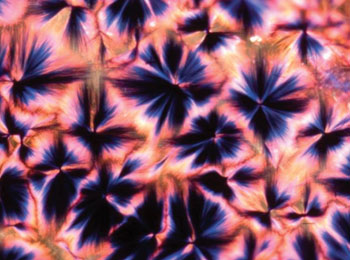Diagnostic Method Created Based On Birefringence
By LabMedica International staff writers
Posted on 20 Dec 2015
A new diagnostic method has been created based on birefringence, which is the ability of substances to change the polarization state of light. With this method, doctors around the world could easily, rapidly, and reliably detect pathogenic microorganisms. Posted on 20 Dec 2015
Although the concept behind this new technology is very general and appears so easy to operate, the scientific basis underlying the invention is extremely complex. The phenomenon of birefringence of polarized light from the lipid based lyotropic liquid crystals, which consist of self-assembled structures of fat molecules in water.

Image: The birefringence pattern of a sample positive to Ebolavirus infection (Photo courtesy of Jijo Vallooran /ETH Zurich).
Scientists at the Swiss Federal Institute of Technology (ETH; Zurich; Switzerland) used lipidic cubic phases that are optically isotropic, transparent lyotropic liquid crystals (LC), containing highly confined water nanochannels in-between percolating lipid bilayers following defined space groups. Due to this nano-confinement, the water in these systems provides a unique environment for chemical and enzymatic reactions.
During the mesoperoxidase enzymatic reaction, the converted product crystallizes within the mesophase domains, generating a detectable birefringence signal and a new general assay principle is presented for the detection of an unprecedented vast class of analytes using such birefringence as sole optical output signal. The team used polarized light microscopy and a small amount of the cubic phase was analyzed under cross-polarized light using an Axioskop 2 MOT microscope (Zeiss; Oberkochen, Germany) at 37 °C. The polarization device costs CHF 20, which considerably less expensive when compared with other detection methods.
By exploiting bienzymatic cascade reactions or introducing an enzyme-linked immunosorbent assay based on birefringence (Birefringent-ELISA), this approach was used for real-time detection of exemplary analytes, such as glucose and cholesterol, model pathogenic microorganisms, Escherichia coli, and viruses such as Ebola and human immunodeficiency virus (HIV). The team also showed how the same technology enables the rapid, naked-eye screening of malaria infection via in meso detection of hemozoin crystallites. Pathogens can be detected very rapidly, and a reliable result received within less than an hour.
Raffaele Mezzenga, PhD, a professor and lead author of the study said, “The Plasmodium parasite invades erythrocytes and digests hemoglobin. The heme component, which is toxic to the parasites, is crystallized and thus has inherently birefringent surfaces. So it's not necessary to mark it with antibodies and no enzymatic reaction is required.” The study was published in the November 2015 issue of the journal Advanced Functional Materials.
Related Links:
Swiss Federal Institute of Technology
Zeiss













